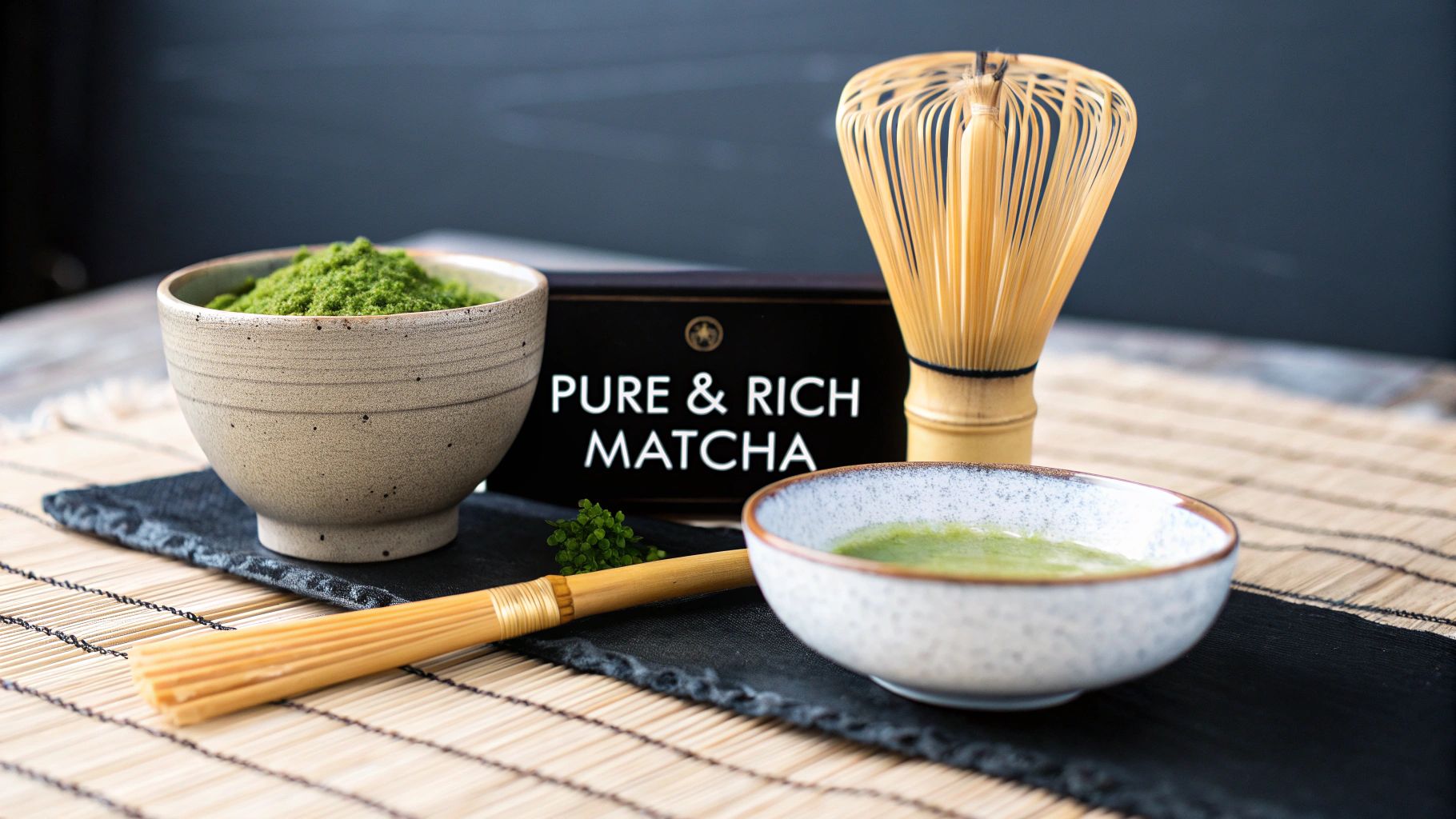When you first venture into the world of matcha, you quickly realise not all green tea powders are created equal. The term "ceremonial organic matcha" isn't just a marketing buzzword; it's a mark of exceptional quality, a promise of purity, and a far richer sensory experience.
Think of it this way: you wouldn't use a vintage, first-press olive oil for high-heat frying, would you? You'd save its delicate flavour to be appreciated on its own. It’s the same with matcha. Ceremonial grade is that exquisite "first press" – meant to be savoured in its purest form.
What Truly Makes Matcha "Ceremonial"?
The difference between ceremonial and culinary matcha lies in its very origins. Ceremonial grade is the absolute pinnacle, crafted exclusively from the Ichibancha—the very first harvest of the year. These are the youngest, most tender, and nutrient-dense leaves from the Camellia sinensis plant.
This careful, once-a-year selection gives ceremonial matcha its signature profile: a remarkably smooth, naturally sweet flavour with deep, savoury umami notes and almost no bitterness. It’s a world away from the matcha you might find in a latte or a baked good.
The Tell-Tale Signs of Superior Quality
You don't need to be a seasoned tea master to spot high-quality matcha. Your senses will tell you everything you need to know.
- Vibrant Colour: Look for a brilliant, almost electric green. This isn't artificial; it's the result of shade-growing the tea plants for weeks before harvest, which forces them to overproduce chlorophyll. A dull, yellowish, or brownish hue is a dead giveaway of a lower-grade, later-harvest, or poorly stored powder.
- Silky Texture: The powder should feel incredibly fine and smooth between your fingers, almost like talcum powder. This is the result of a slow, meticulous stone-grinding process that preserves the nutrients and flavour. If it feels coarse or gritty, it's likely a culinary grade better suited for cooking.
- Smooth Flavour: The taste is the ultimate test. It should be complex and smooth with a delicate, natural sweetness and that rich, savoury "umami" finish. It shouldn’t have the harsh bitterness you might find in lesser-quality matcha. This is why it’s perfect for drinking with just hot water—nothing needs to be masked.
This commitment to quality is catching on. As more people look for mindful, health-focused drinks, the UK matcha market is set to grow from USD 340 million in 2025 to around USD 790 million by 2031. It’s clear the appreciation for antioxidant-rich, high-quality drinks is on the rise.
The distinction is simple yet profound. With ceremonial grade, you are consuming a beverage crafted for a mindful ritual. With culinary grade, you are using an ingredient.
Why "Organic" Is Non-Negotiable
Choosing organic isn't just a preference; it's a crucial final piece of the puzzle. With matcha, you consume the entire tea leaf, powder and all. That means anything sprayed on the plant during cultivation ends up directly in your bowl.
Organic certification guarantees that the tea was grown using natural, sustainable farming methods, free from synthetic pesticides and fertilisers. This ensures a pure, clean product. Amatsu Matcha was founded on this principle, ensuring every product—from our foundational Pure blend to our functional Shrooms matcha—begins with the highest quality organic leaves, so you can focus on the ritual without a second thought.
To help clarify the differences, here’s a quick comparison:
Ceremonial Organic Matcha vs Culinary Matcha at a Glance
This table breaks down the key attributes that separate the matcha meant for mindful sipping from the matcha designed for cooking.
| Attribute | Ceremonial Organic Matcha | Culinary Grade Matcha |
|---|---|---|
| Harvest Time | First Harvest (Ichibancha) | Second, Third, or Autumn Harvest |
| Colour | Vibrant, electric green | Dull, yellowish-green |
| Texture | Ultra-fine, silky powder | Coarser, slightly gritty |
| Flavour Profile | Smooth, naturally sweet, rich umami | More astringent, slightly bitter |
| Best For | Drinking with water (Usucha/Koicha) | Lattes, smoothies, baking, cooking |
| Price Point | Higher | More affordable |
Ultimately, choosing ceremonial organic matcha is an investment in both tradition and your own well-being. To dive even deeper, you can learn more about what sets ceremonial grade matcha apart and fully appreciate the craft behind every scoop.
The Rich Heritage Inside Every Bowl of Matcha
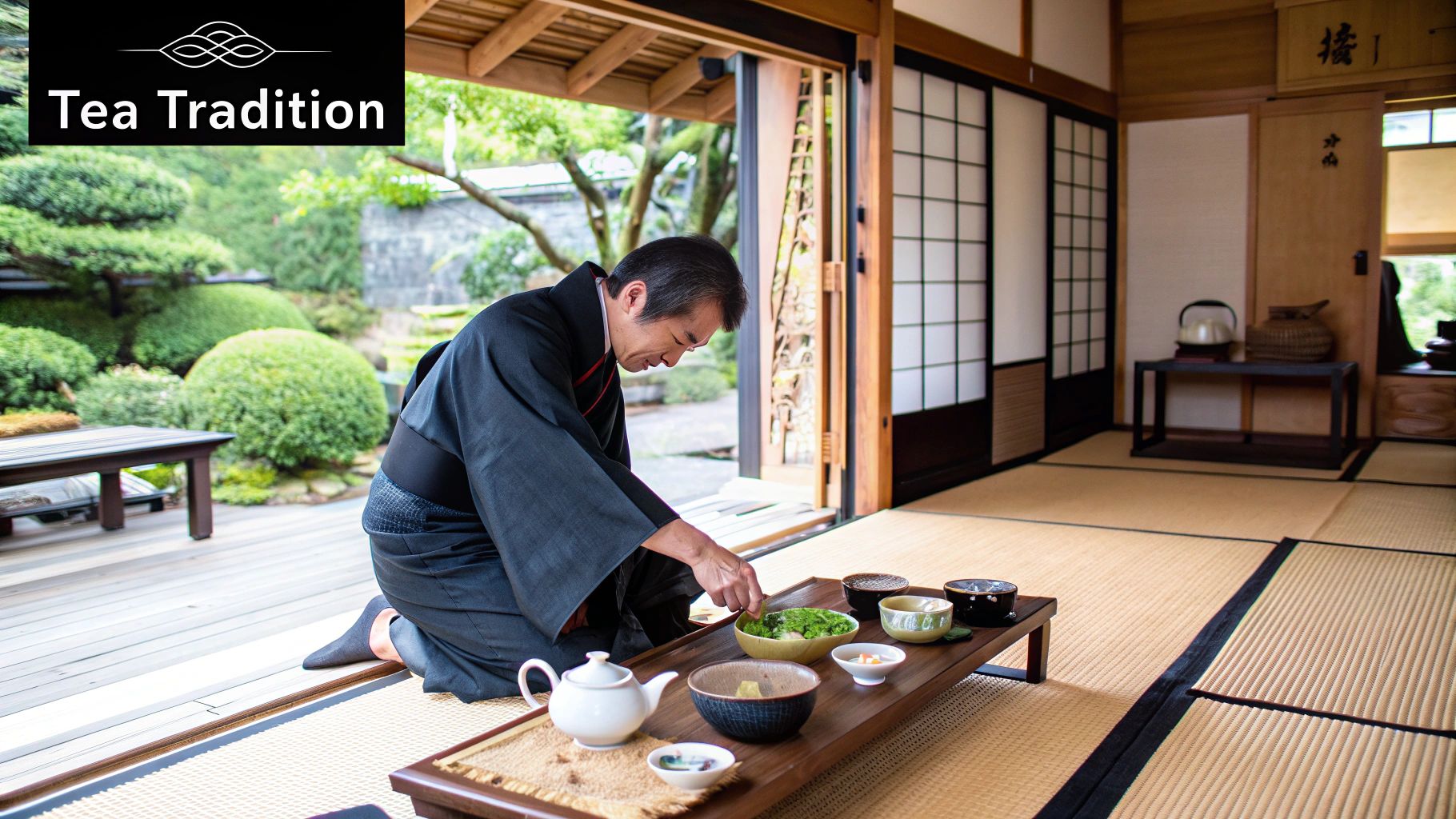
When you enjoy a bowl of ceremonial organic matcha, you're not just having a drink. You’re taking part in a tradition that winds back almost a thousand years, a story rooted not in mass production, but in the quiet mindfulness of ancient Japanese temples.
Matcha first arrived in Japan from China, where it was quickly adopted by Zen Buddhist monks. They found its unique properties helped them stay alert yet calm, making it the perfect companion for long, silent hours of meditation. It offered a focused, sustained clarity—a world away from a sudden coffee jolt.
This deep spiritual connection cemented matcha's place at the heart of Japanese culture. Over centuries, the simple act of preparing and drinking this powdered green tea blossomed into a deeply respected and beautiful art form: Chadō, or "The Way of Tea."
The Four Pillars of Chadō
The Japanese tea ceremony is far more than just a ritual; it’s a living philosophy built on four guiding principles. These ideals are not only woven into the ceremony but are also reflected in how true ceremonial grade matcha is painstakingly cultivated.
- Wa (Harmony): This speaks to the harmony between the people, nature, and the tea utensils. Every element works together to create a feeling of shared peace.
- Kei (Respect): This principle encourages humility and gratitude. Respect is shown for the tools, the tea itself, and every person present.
- Sei (Purity): This refers to the physical cleanliness of the tea space, but also to the spiritual purity of heart and mind among those participating.
- Jaku (Tranquillity): This is the ultimate goal. The ceremony aims to cultivate a profound sense of inner calm that you can carry with you long after the last sip.
Guided by these principles, a simple bowl of tea becomes a moving meditation. The very act of preparing matcha—the sifting, the whisking—is a practice in mindfulness, a gentle nudge to slow down and be fully present.
"The spirit of the tea ceremony is pure and clean. To be able to share a bowl of tea is to be able to drink from the same spring of spiritual purity."
From Ancient Practices to Modern Quality
This incredible heritage is directly tied to the exceptional quality you find in a premium matcha. The traditional cultivation methods, refined over countless generations, are precisely what give ceremonial organic matcha its stunning colour and complex, nuanced flavour.
Take the practice of shade-growing. For three to four weeks before harvest, the tea plants are carefully covered. This legacy technique stresses the plants just enough, forcing them to produce more chlorophyll and L-theanine. The result? That brilliant green hue and a deep, savoury umami flavour that’s impossible to replicate.
After this shading period, only the youngest, most tender leaves are hand-picked from the very top of the plant. Finally, these precious leaves are slowly stone-ground into a powder so fine it feels like silk. It’s a painstaking process—it can take an entire hour to grind just 30g—but it’s essential for preserving the tea’s delicate nutrients and creamy texture.
These aren’t just steps on a production line; they are acts of artistry, honouring centuries of tradition. Every sip connects you to this rich history and the mindful philosophy that created it. Understanding this heritage helps you appreciate the full spectrum of matcha's amazing health benefits, which go far beyond basic nutrition.
Exploring the Wellness Benefits of Matcha
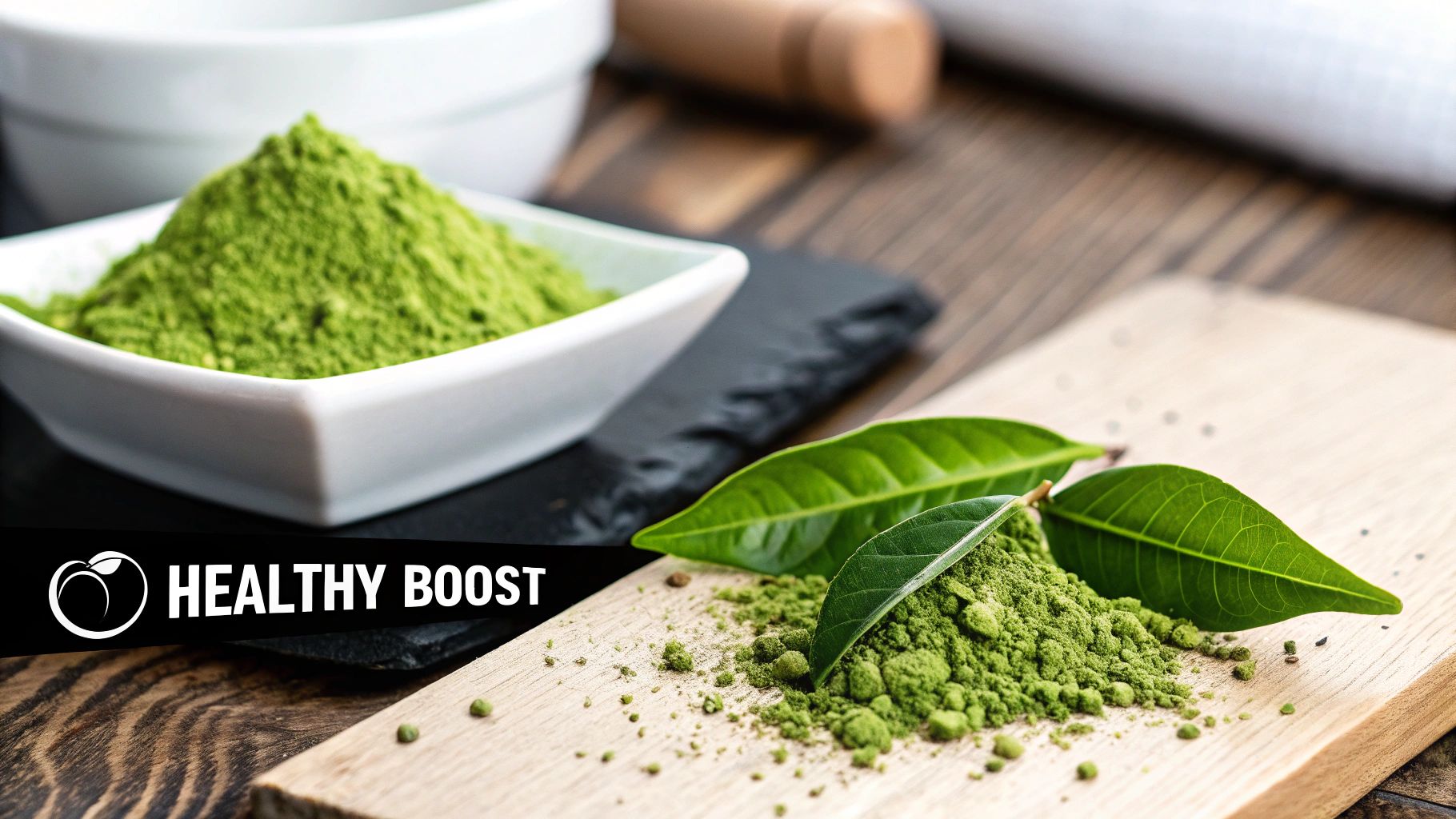
Beyond its stunning colour and deep cultural story, ceremonial organic matcha is a true powerhouse of wellness. Every bowl is packed with a symphony of plant-based compounds that work in harmony to support your mind and body. It’s not just about a momentary lift; it’s about making a consistent, positive difference to your overall health.
The real secret is that when you drink matcha, you’re consuming the entire tea leaf. With steeped teas, you throw the leaves away after brewing, but with matcha, every bit of that nutrient-rich powder is suspended in your drink. This whole-leaf approach is precisely what makes it so exceptionally potent.
A Rich Source of Antioxidants
At the very heart of matcha's health profile are its antioxidants, particularly a group of compounds called catechins. You can think of these as your body’s personal security guards, working to neutralise damaging free radicals—those unstable molecules that can stress our cells and contribute to ageing.
Matcha is uniquely rich in one of the most powerful catechins we know of: epigallocatechin gallate (EGCG). In fact, research suggests matcha can contain up to 137 times more EGCG than other types of green tea. This makes it an incredibly effective way to bolster your body’s natural defences.
By making a daily bowl of ceremonial organic matcha part of your routine, you're giving your body a concentrated dose of cell-protecting compounds that support long-term wellness.
Choosing an organic matcha, like the blends from Amatsu Matcha, is key. Our Radiance blend, for example, combines premium matcha with collagen and biotin, leveraging this antioxidant base to support glowing skin from within. An organic certification guarantees your antioxidant boost is pure and completely free from synthetic pesticides or chemical residues.
The Magic of L-Theanine: Calm Alertness
Ever had that jittery, anxious feeling from a strong cup of coffee, followed by the inevitable crash? Matcha offers a beautifully different kind of energy, all thanks to a rare amino acid called L-theanine. This incredible compound is what sets matcha apart from almost every other source of caffeine.
L-theanine works with the natural caffeine in matcha to create a state of calm alertness. Instead of a sharp, jarring energy spike, you get a smooth, sustained lift that keeps you focused and clear-headed for hours.
Here’s a look at how this unique synergy plays out:
- Promotes Alpha Waves: L-theanine encourages the production of alpha brain waves, which are linked to a state of relaxed wakefulness and mental clarity—the same state often reached during meditation.
- Smooths out Caffeine: It tempers the effects of caffeine, preventing the typical jitters and anxiety. This lets you enjoy heightened focus without the uncomfortable side effects.
- Supports Cognitive Function: The combination of L-theanine and caffeine has been shown to improve attention, memory, and reaction time, making it the perfect companion for a productive workday or a creative session.
This is the focused calm that Zen Buddhist monks prized centuries ago. A bowl of matcha provides an energy that feels both grounding and elevating, giving you sharp focus without sacrificing your sense of peace. For an even greater physical boost, our Strength blend pairs matcha with creatine to support both mental focus and physical power.
Supporting Metabolism and Overall Vitality
Beyond its immediate effects on your mind, ceremonial organic matcha can also play a big role in your physical well-being. That potent concentration of EGCG, in particular, has been linked to positive effects on metabolic health.
Some studies suggest that the compounds in green tea can help boost thermogenesis—the rate at which your body burns calories. While it’s certainly not a magic bullet, making matcha a part of a balanced lifestyle can be a fantastic way to support a healthy metabolism.
What’s more, the combination of antioxidants and other phytonutrients contributes to your overall vitality, from supporting your immune system to simply promoting a sense of well-being. To dive deeper into how it all works, you can explore our complete guide to the world of Japanese green tea and matcha. Each sip is a small, powerful step towards a more balanced you.
The Journey from Tea Leaf to Fine Powder
Have you ever wondered how a simple tea leaf becomes that vibrant, emerald-green powder we know as ceremonial organic matcha? It’s not a journey of speed but one of patience, precision, and craftsmanship passed down through generations. This is a story of meticulous care, where every single step is designed to coax out and preserve the incredible qualities that make this tea so special.
It all starts in dedicated Japanese tea fields, where only the finest Camellia sinensis plants are cultivated. The first, and arguably most important, step is what gives high-grade matcha its signature flavour and colour.
The Art of Shading the Leaves
Roughly three to four weeks before the spring harvest, the tea plants are carefully covered with dark cloths, blanketing the fields in shade. This simple act dramatically reduces the sunlight reaching the leaves.
Starved of light, the plants kick into overdrive, producing a flood of chlorophyll that results in their iconic, electric green hue. This gentle stress also boosts the production of L-theanine, the amino acid that gives matcha its famous umami depth and its wonderfully calming effect on the mind.
Once the shading period is over, only the youngest, most tender leaves from the very top of each plant are painstakingly hand-picked. This first harvest, or Ichibancha, guarantees that only the most flavourful and nutrient-rich leaves move on to the next stage.
This dedication to tradition is what sets ceremonial grade apart. It’s not just about growing tea; it's about curating an experience, ensuring every tin from a brand like Amatsu Matcha lives up to its promise of exceptional quality.
After the harvest, the leaves are immediately steamed for 15-20 seconds. This is a critical moment. Steaming halts the oxidation process, locking in that brilliant green colour and preserving the fresh, vegetal aroma and delicate nutrients. It's a race against the clock to capture the leaf at its absolute peak.
This careful process is gaining a serious following worldwide. Ceremonial grade matcha already accounts for around 34% of premium matcha revenue in Europe. The UK, with its thriving café culture and wellness focus, is leading the charge, falling in love with the authentic flavour of high-quality organic matcha. You can discover more insights about the premium matcha market and its growing appeal.
Crafting Tencha: The Heart of Matcha
Once steamed, the leaves are slowly dried. Then comes the laborious task of de-stemming and de-veining them by hand, a meticulous job that removes any trace of bitterness or coarse texture. What’s left behind is the pure, tender heart of the leaf, a material known as tencha.
Tencha is the raw ingredient for matcha. It's not yet the fine powder you find in your kitchen, but it's the purest expression of the tea leaf, poised for its final, beautiful transformation.
The image below shows the traditional, simple steps for preparing the final powder into a perfect bowl.
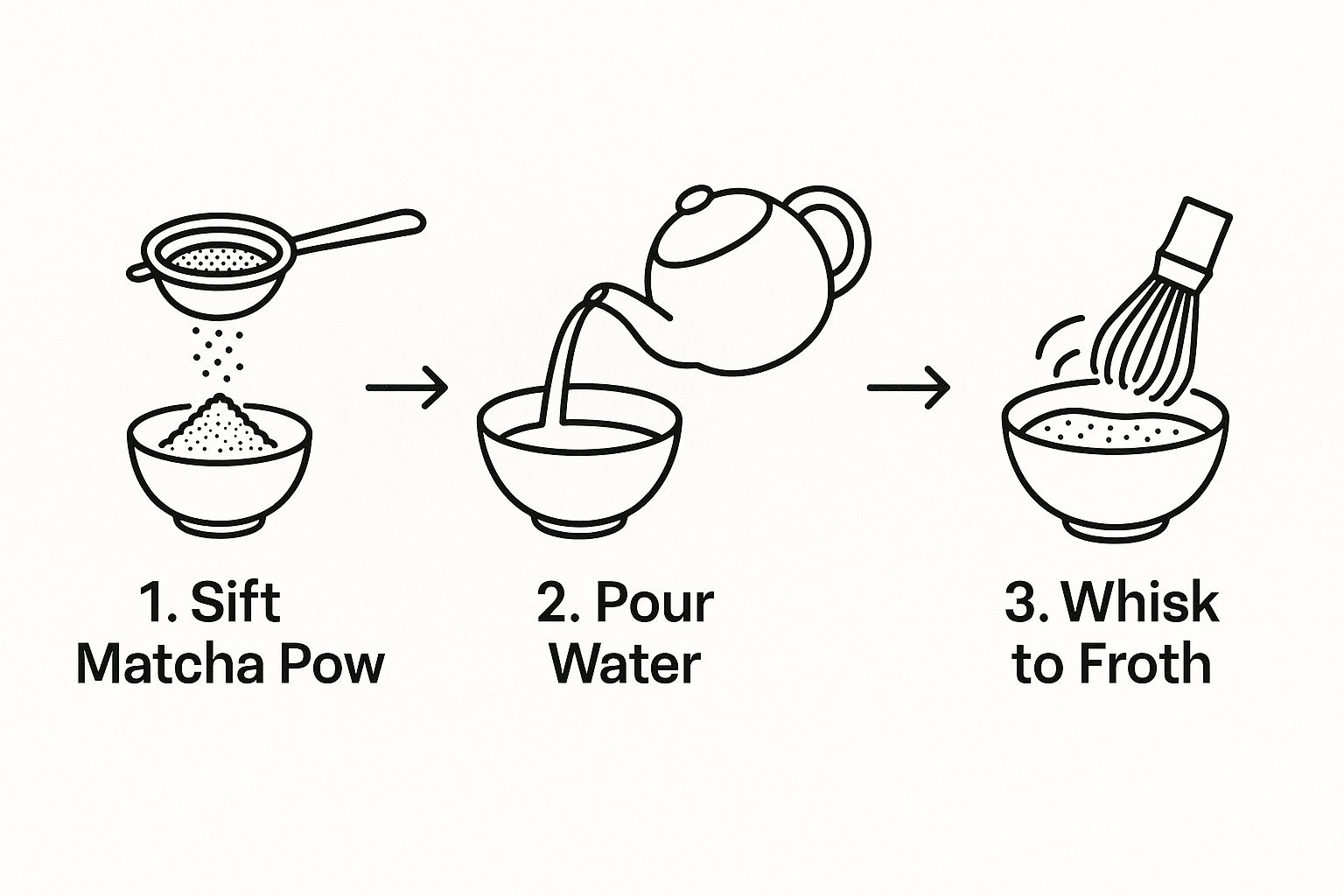
This beautifully illustrates the mindful actions—sifting, pouring, and whisking—that honour the quality of the carefully produced powder.
The Final Grind: A Slow Transformation
The last step is perhaps the most defining of all: stone-grinding the tencha into an impossibly fine powder. Traditionally, this is done with large granite stone mills that turn incredibly slowly. This unhurried pace prevents any heat from building up, which would otherwise ruin the matcha’s delicate flavour, aroma, and nutrients.
It’s an unbelievably time-consuming process. It can take a full hour to grind just 30-40 grams of matcha. The result is a powder so fine—around 5-10 microns—that it feels like silk and dissolves perfectly in water, creating that signature smooth, creamy froth. This is what you pay for with premium ceremonial organic matcha: a guarantee that every sip is nothing short of exceptional.
How to Choose the Best Ceremonial Organic Matcha
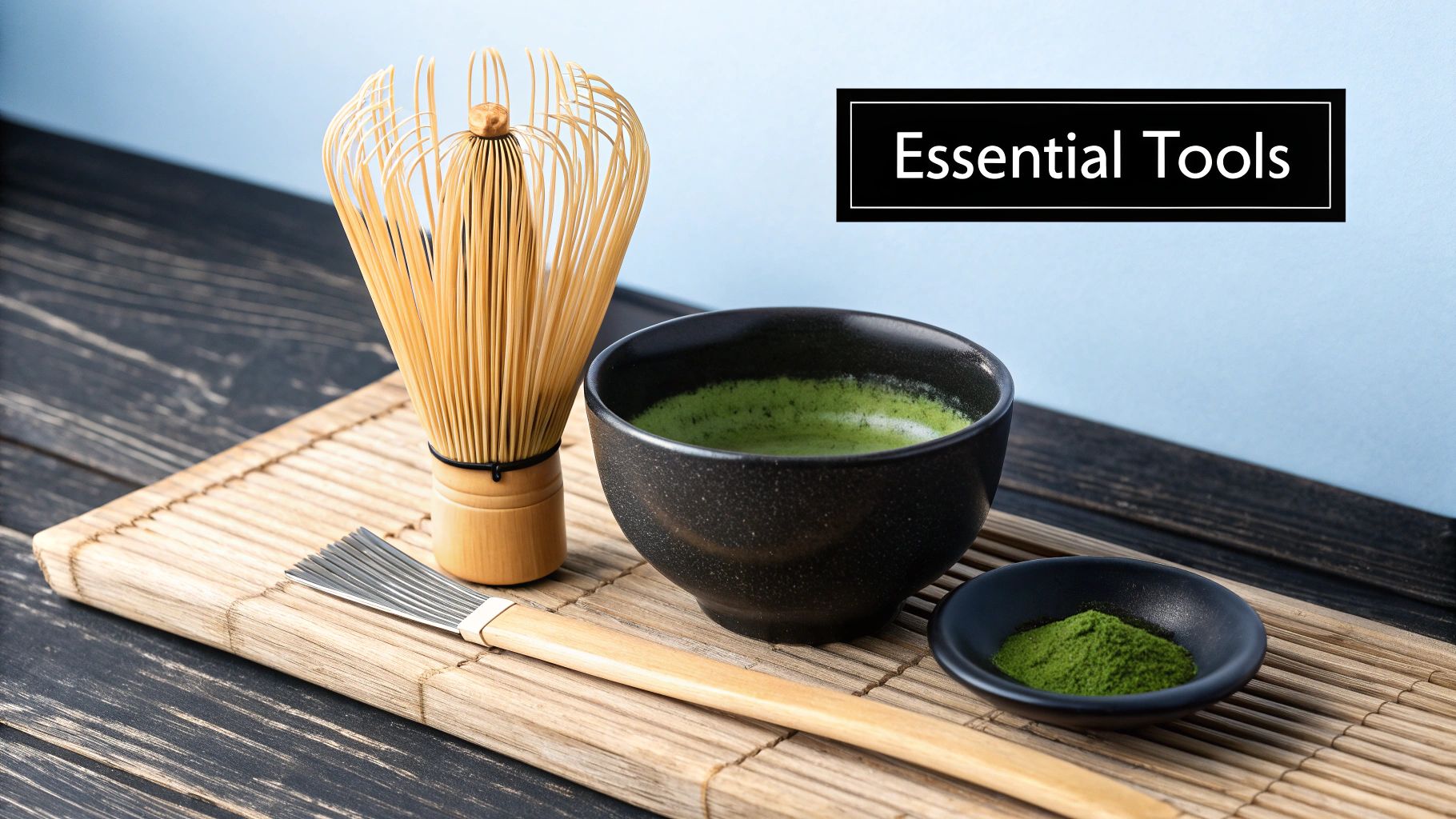
Stepping into the world of matcha can feel a bit overwhelming at first, but figuring out how to choose a high-quality product is simpler than you think. With a little guidance, you can quickly learn to spot the real deal. It’s a lot like picking out the best fresh produce at a market—your own senses are your most trustworthy guides.
The most immediate giveaway is the colour. Real ceremonial grade matcha boasts a vibrant, almost electric green hue. This stunning shade is a direct result of the high chlorophyll levels that build up while the tea leaves are shade-grown, and it's a sure sign they were harvested at just the right moment.
If you pop open a tin and find a dull, swampy green or a powder tinged with yellow, that’s a big red flag. It usually points to a lower-grade product, leaves from a later harvest, or matcha that's simply old and has started to oxidise.
Judging by Touch and Scent
After colour, get a feel for the texture. Top-tier matcha is stone-ground into an incredibly fine powder, typically around 5 to 10 microns. When you rub a pinch between your fingers, it should feel silky and smooth, almost like eyeshadow or talc.
A gritty, coarse texture tells you the grinding process wasn't up to scratch. That kind of matcha won’t dissolve properly in water, and you'll miss out on that signature creamy, frothy mouthfeel. The final sensory check is the aroma. Open the tin and take a good sniff. It should smell fresh, sweet, and vegetal, with those lovely rich umami notes coming through.
A premium ceremonial organic matcha should never smell stale, dusty, or like hay. A bright, inviting aroma is a clear sign of freshness and quality, promising a delightful experience in every bowl.
Verifying Origin and Purity
When it comes to matcha, authenticity is everything. The very best ceremonial grades come from Japan's most famous tea-growing regions, with Uji (in the Kyoto Prefecture) being the most prestigious of all. Always check the packaging to make sure it clearly states its Japanese origin.
Just as crucial is the organic certification. Remember, with matcha, you’re consuming the entire tea leaf. Choosing organic means you can be confident it's free from synthetic pesticides and fertilisers, giving you a pure, clean taste and total peace of mind.
This desire for pure, high-quality matcha is on the rise. In fact, the UK matcha tea market is expected to hit USD 98.3 million by 2030, and powdered matcha is the biggest part of that puzzle. Ceremonial organic matcha is a huge driver of this growth as more and more people look for products with authentic, clean origins.
By keeping an eye out for these key markers—vibrant colour, silky texture, fresh aroma, Japanese origin, and organic certification—you can shop with confidence. Products like Amatsu Matcha's Pure and Radiance blends are crafted to meet these exacting standards, delivering an authentic experience every time. For a deeper dive, check out our guide on finding the best quality matcha for your daily ritual.
Mastering the Art of Brewing Perfect Matcha
Making a traditional bowl of ceremonial organic matcha at home is a beautiful, grounding ritual. And honestly, it’s much simpler than it looks. Forget any sense of intimidation; this is about turning a vibrant green powder into a perfect, frothy brew and creating a mindful pause in your day.
The whole process is designed to honour the quality of the matcha, making sure its delicate flavour and creamy texture really shine through. With the right tools and a bit of practice, you’ll be creating a café-quality experience right in your own kitchen. It all starts with a few key items.
Gathering Your Essential Tools
To do it the traditional way, you’ll want a few specific pieces of equipment. While you can improvise with modern gadgets, these classic tools are purpose-built to bring out the very best in your tea.
- Chawan (Matcha Bowl): A wide, flat-bottomed bowl is essential. It gives you plenty of room to get a good whisking action going.
- Chasen (Bamboo Whisk): This is non-negotiable. Its fine, flexible tines are designed specifically to aerate the matcha and create that signature creamy foam.
- Chashaku (Bamboo Scoop): The traditional way to measure out the perfect amount of matcha powder for a single serving.
You'll also need a small sifter. This is a crucial step for achieving that silky, lump-free consistency. Sifting the powder makes all the difference.
The secret to a perfect bowl of matcha isn’t complexity; it’s mindful preparation. The simple acts of sifting, measuring, and whisking connect you to a centuries-old tradition of calm focus.
The Step-by-Step Brewing Ritual
Ready to whisk? Here’s a simple process for making a traditional bowl of usucha, or thin tea.
- Heat Your Water: Bring some fresh, soft water to a near boil, then let it cool down to around 80°C (176°F). This is key—if the water is too hot, it will scorch the delicate tea leaves and make your matcha taste bitter.
- Sift Your Matcha: Place a sifter over your chawan and measure 1-2 bamboo scoops (that's about half a teaspoon) of Amatsu Matcha into it. Gently push the powder through to break up any little clumps.
- Add Water: Pour about 60-70ml of the warm water over the sifted matcha in the bowl.
- Whisk Vigorously: Take your chasen and whisk in a quick "W" or "M" pattern, not in circles. Keep this up for about 20-30 seconds until you have a rich, thick layer of fine foam on the surface.
For a more detailed walkthrough, you can follow our complete guide on how to prepare matcha perfectly every time.
If you're in the mood for a modern twist, making a matcha latte is just as easy. Simply prepare the matcha as a concentrated shot with less water (30-40ml) and then pour it over your favourite steamed milk. It’s a great way to enjoy a creamy, comforting latte while still honouring the quality of the ceremonial powder.
Your Ceremonial Matcha Questions, Answered
As you get started with matcha, a few questions are bound to pop up. We’ve put together some answers to the most common ones, so you can feel confident as you choose, prepare, and enjoy your new ritual.
Can I Use Ceremonial Matcha for Lattes and Baking?
You absolutely can, but it’s a bit like using a fine, aged red wine for a casserole. You'll still get a good result, but you’ll lose all the delicate, nuanced notes that make it so special in the first place.
The subtle sweetness and deep umami of ceremonial matcha are really meant to be savoured on their own with hot water. For lattes, smoothies, or baking, a high-quality culinary grade matcha is often the better (and more economical) choice. Its bolder flavour stands up beautifully to milk and other ingredients.
What Does ‘Organic’ Really Mean for Matcha?
When we talk about organic matcha, we mean it’s been grown without any synthetic pesticides, herbicides, or chemical fertilisers. The farmers rely on time-honoured, natural techniques to enrich the soil and care for the tea plants.
Because you’re consuming the entire leaf when you drink matcha—not just an infusion—choosing organic is particularly important. It’s your guarantee that the vibrant green powder in your bowl is pure, clean, and free from any unwanted chemical residues. All Amatsu Matcha products are certified organic for this reason.
How Should I Store My Matcha to Keep It Fresh?
Matcha is incredibly delicate. Its biggest enemies are light, air, and heat, all of which can quickly sap its brilliant colour and complex flavour. Good storage is non-negotiable.
Always keep your matcha sealed in a proper airtight container (the tin it arrives in is perfect). Find a cool, dark spot for it, like a kitchen cupboard away from the oven. For long-term storage, you can even pop the sealed tin in the fridge. Just be sure to let it come back to room temperature before you open it, otherwise condensation can get in and make the powder clump.
Ready to experience the art of a true ceremonial brew? Amatsu Matcha offers meticulously sourced, first-harvest organic matcha from Uji, Japan—the foundation for clean energy, mindful focus, and enhanced wellness in every blend. Whether you seek purity, radiance, strength, or cognitive balance, our collection is crafted for your ritual.
Discover the Amatsu Matcha collection and begin your ritual today.
Read more
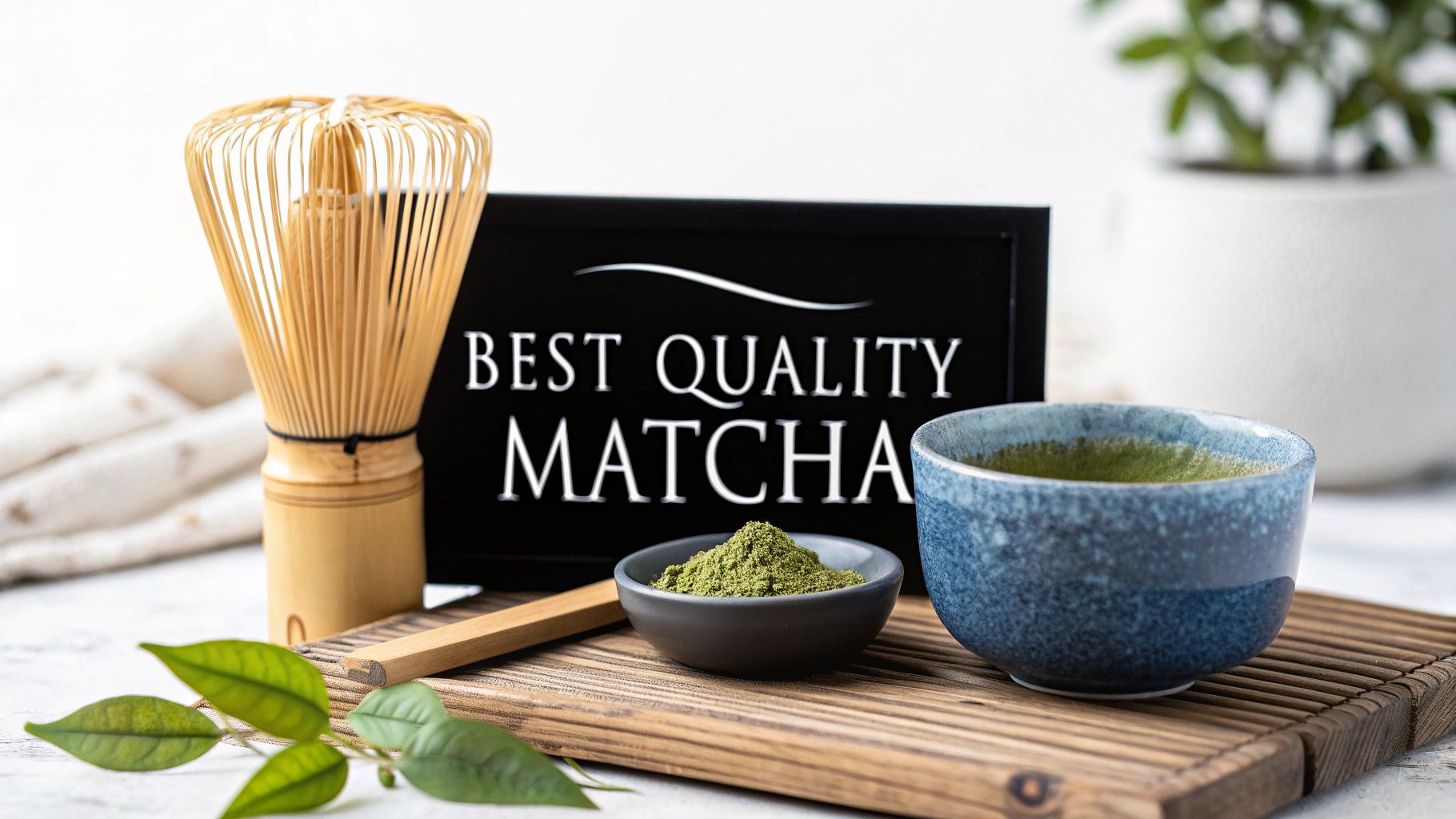
Discover how to identify the best quality matcha. This guide covers grades, color, origin, and brewing to help you choose the perfect cup every time.
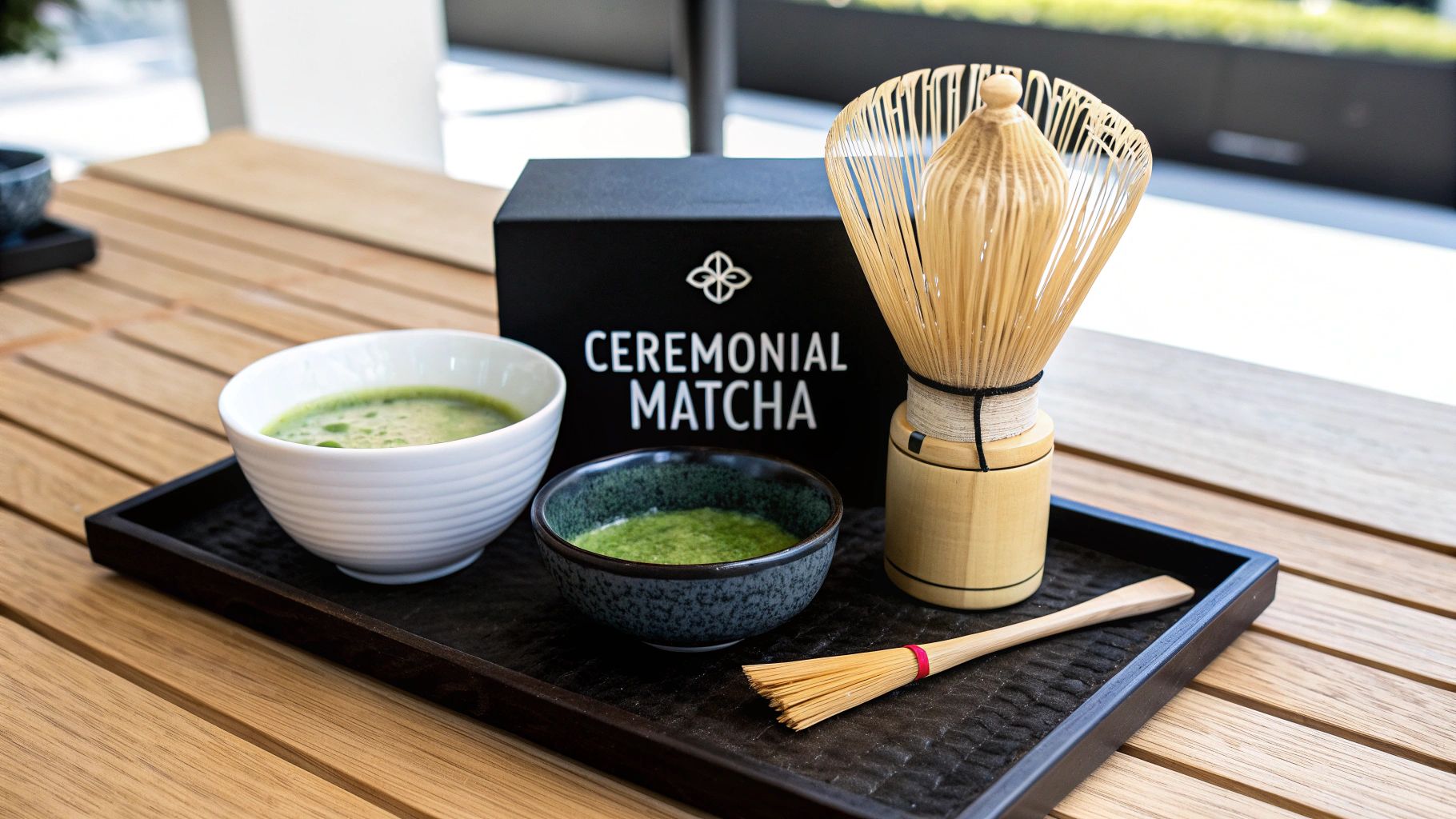
Discover the essential tools in a ceremonial matcha tea set. This guide explains how to choose, use, and care for your set to create the perfect bowl of matcha.
